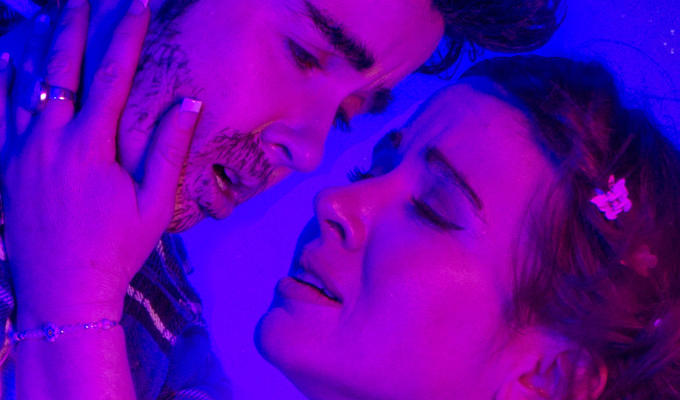
A brief history of gunge
Crackerjack biographer Alan Stafford on the comedy staple of kids' TV
In 1982 Ian and Janette Krankie defected from BBC to ITV, leaving Paul Ciani, producer of long-running teatime variety show Crackerjack, with a gap that needed filling. Rather than recruit a new comedy team, he decided on a rota of guest stars, among them Geoffrey Durham in character as curly-wigged Spanish magician The Great Soprendo.
Geoffrey recalls: ‘I was actually at a meeting in which Paul Ciani invented the gunge drop, an absolute staple of children’s television for about ten years. That, if you got the question wrong, you got covered in crap.’
So out went the comedy sketch and in came Take A Chance – a messy conclusion to the already pretty yucky Take A Letter – in which a celebrity vied with host Stu Francis to help a kid win a better prize. They sat in booths not unlike toilet cubicles with transparent glass cisterns high above, screened off from the audience until both participants were seated. Then the screen was raised, revealing both the contents and the descriptive name they had been given.
‘After that, lots of shows got the gunge tanks,’ says Stu. ‘Even that Noel Edmonds thing [Noel’s House Party]. But it was Ciani who came up with the idea of the gunge tanks, because he wanted a big finale that people would remember. They once gunged Les Dawson, and covered him in two gallon of mushy peas. And you can’t get more Lancashire than that!’
From then on gunge became top-of-the-bill. But not everybody was happy. ‘They started off with baked beans and other such items,’ remembers Geoffrey Durham. ‘And then they got complaints. A vicar really seriously complained that food was being dropped on people, when people were starving in other countries.
'So there was a crisis meeting in which Paul Ciani and his associates decided to concoct gunge that they would call different things that weren’t food. They’d call it Nasty Frogs or Slime. So slime would drop on people, and that was suddenly acceptable.’
If any member of the team could be called the ‘gunge chef’ it was Crackerjack’s assistant floor manager Nick Fiveash. ‘Each week I would ask the props department to deliver about 12 gallons of white custard in plastic dustbins.
'I would then proceed to mix in food colouring and little objects. I remember one week doing toothpaste. I managed to put a clear pipe into the gunge tank and pour red food colouring in. And as I pulled the tube out, the red colouring made stripes in the white custard.’
But how does it feel to be gunged? ‘Once it happens, it’s alright,’ says Stu. ‘It’s just that second waiting. You know it’s going to come. Sometimes you’d just be thinking, "Oh, get it over with. Just do it." It’s that split-second knowing it’s coming. Once you were covered, that were it. It was just finish the number at the end and leg it to the showers.’
Crackerjack finished its 29-year run in 1984, after struggling in the ratings against ITV’s own ‘take a letter’ quiz Blockbusters. Then, to everyone’s astonishment, the show was revived on CBBC in 2020 with hosts Sam Nixon and Mark Rhodes. Series editor Steve Ryde was determined to retain the traditional ingredients of Crackerjack while providing something that would engage his 21st century audience.
Double or Drop, the game with armfuls of prizes and booby prize cabbages, which had been part of Crackerjack since its first show in 1955, was now played seated on backwards-moving conveyor belts. (The game’s creator and original host, Eamonn Andrews, even got a namecheck in the closing credits.)
The Crackerjack pencil was now jumbo-sized. And the game Splatterjack was clearly inspired by the gunge tanks of the Stu Francis era, except that now the contestant ascended to meet the gunge.
‘I wanted chairs that elevated towards a gunge bubble or tank,’ says Steve Ryde. ‘I liked the sense of height and that your teammate would be the one to raise you up.’ In the first show, two girls were pitched against each other, with their mothers seated on chairs topped with a metal spike. Each correctly answered question won the girl three seconds pushing a handpump, which would move the parent ever closer to the flimsy latex membrane forming the base of the gunge tank. The contents were labelled ‘Cold Lumpy Gravy’ and ‘Slowly Rotting Sprouts,’ although no food was wasted (or indeed used) in preparing the garishly coloured gunge.
Eventually one mother reached the critical height, the spike punctured the membrane and the gunge was released. But, in subsequent shows, this wasn’t always the case. Sometimes the spike just gently nestled into the latex and not one drop of gunge was spilt, much to the frustration of Steve Ryde.
‘In all the tests it had worked … typically! It doesn't fail until you’ve got a huge audience to witness it. It was Sam Nixon’s idea, in the moment, to fish out a Crackerjack pencil and ask the parent to use it to stab the bloody thing. So for series two we had a sort of rotating blade – we meant business!’
Gunge was also an essential part of the comedy routines, performed by the resident Crackerjack sketch troupe. In Trust Building, boss Sandra assembles her workmates around her to catch her before she falls backwards into a pool of gunge.
The workmates are constantly distracted or miss their cue, and Sandra gets repeatedly dunked. Whenever possible, sketches of this kind were rehearsed without gunge (known as a ‘dry run’) to avoid unnecessary costume changes or time spent cleaning up the set.
But this was one of those rare occasions when a ‘wet run’ was called for. ‘I did lots of dry runs, falling back into the pool,’ recalls Kate Malyon. ‘And then I put on some kids’ track suits and did a few falling backs into the gunge, because there were a lot of slip hazards and it was actually quite a big drop.’
Crackerjack returned for its second series at a particularly challenging time for TV production. Coronavirus was at its height, and all the games and sketches were under the constant supervision of the Covid advisor. ‘We called him the Covid King, bless him,’ says co-host Sam Nixon. ‘Every time we were rehearsing a segment, he’d have this two-metre stick that extended. And he’d come in and put it between me, Mark and the kids.’
With strict hygiene measures now in place, the booby prize Cabbages were handed out by the Cabbage Keeper, a mysterious figure in a cabbage costume. But the sketch company, being a ‘close contact cohort,’ were still able to interact and the gunge could flow freely. Perhaps a little too freely in the sketch Gunge Fu, where Ian Kirkby played a Geordie martial arts instructor attempting to teach the mystic skill of self-defence against a series of gunge-wielding assailants. It was a funny sketch, but nobody quite expected it to become a Crackerjack classic.
They’d rehearsed it as a ‘dry run,’ miming all the custard pies and the gunge guns and saving the really messy mayhem for the performance. But as the four of them stood there in judo robes, barefoot on a rubber mat, Ian soon found himself in difficulties. ‘The trouble started when I realised the fallout from the first two pies I’d taken straight in the face had caused the judo mat to become incredibly slippy,’ remembers Ian. ‘To the point where just standing up straight was becoming a problem. More slop followed and thus the more I became unstable on my feet. I remember feeling like Bambi trying to stand for the first time!’
By the end of the sketch the entire cast was lying on the floor slathered in gunge. It was a Jackson Pollock action painting made flesh. Utter hilarious chaos. But then, isn’t that what Crackerjack has always been?
• The updated paperback edition of It’s Friday, It’s Crackerjack! by Alan Stafford is now available now:
Published: 7 Feb 2023






